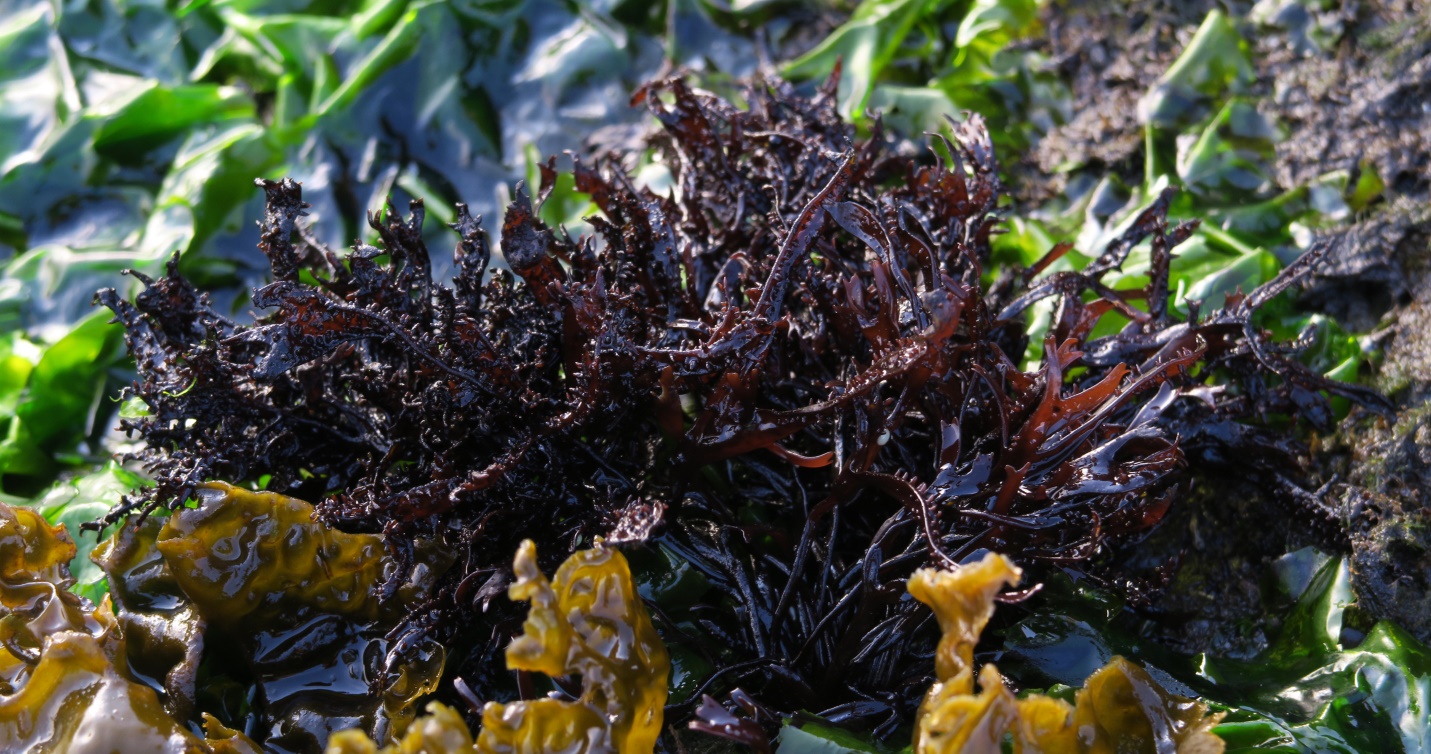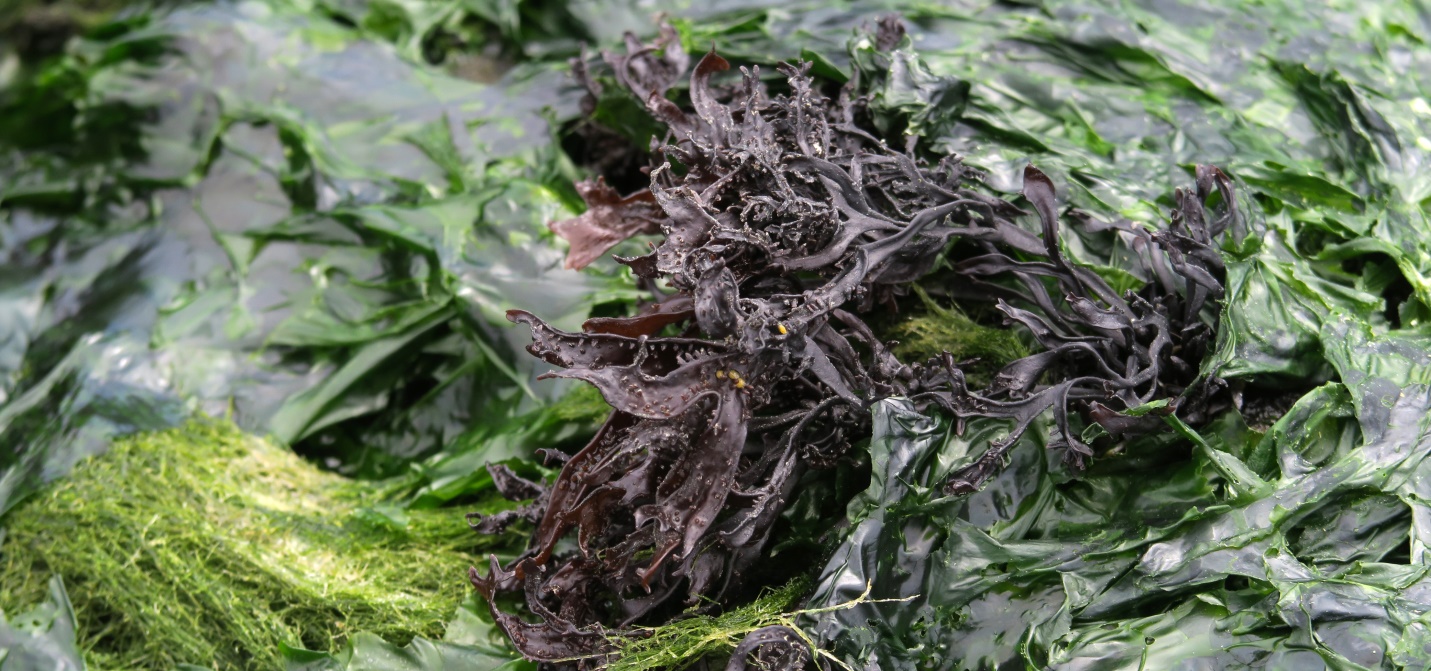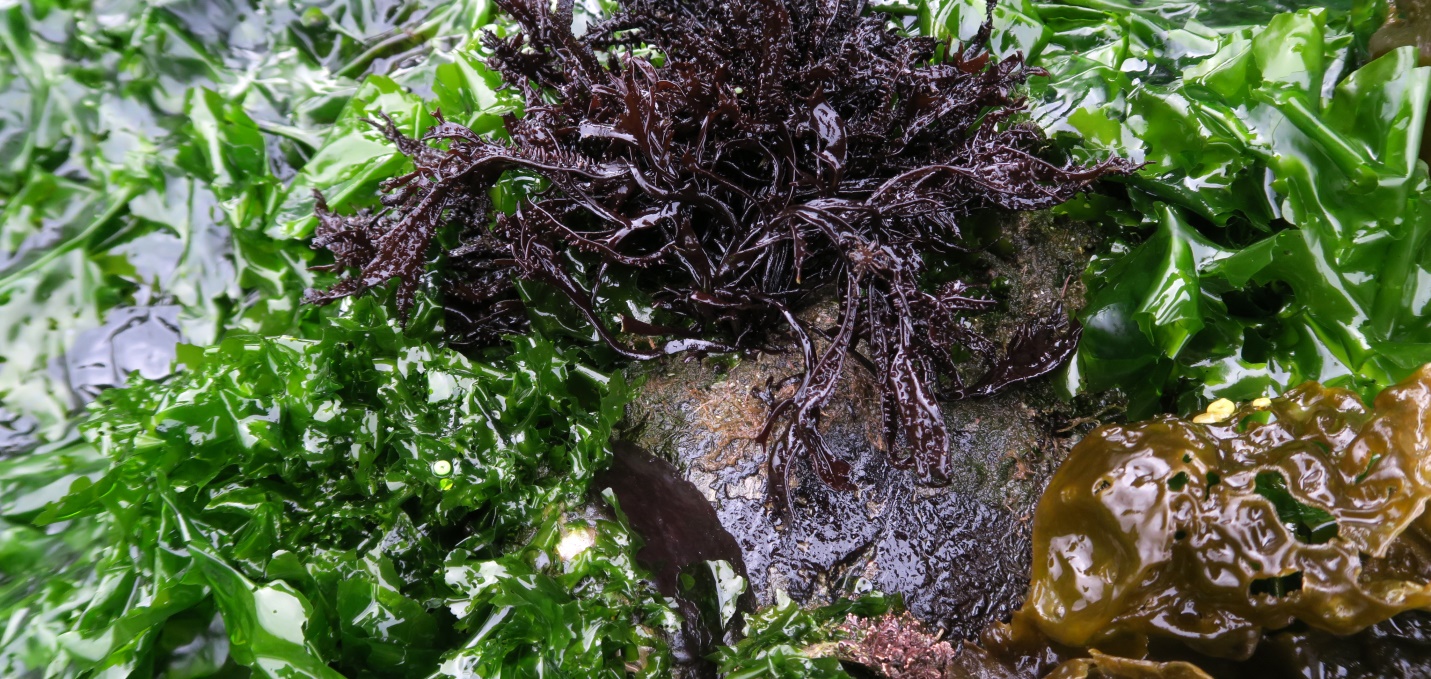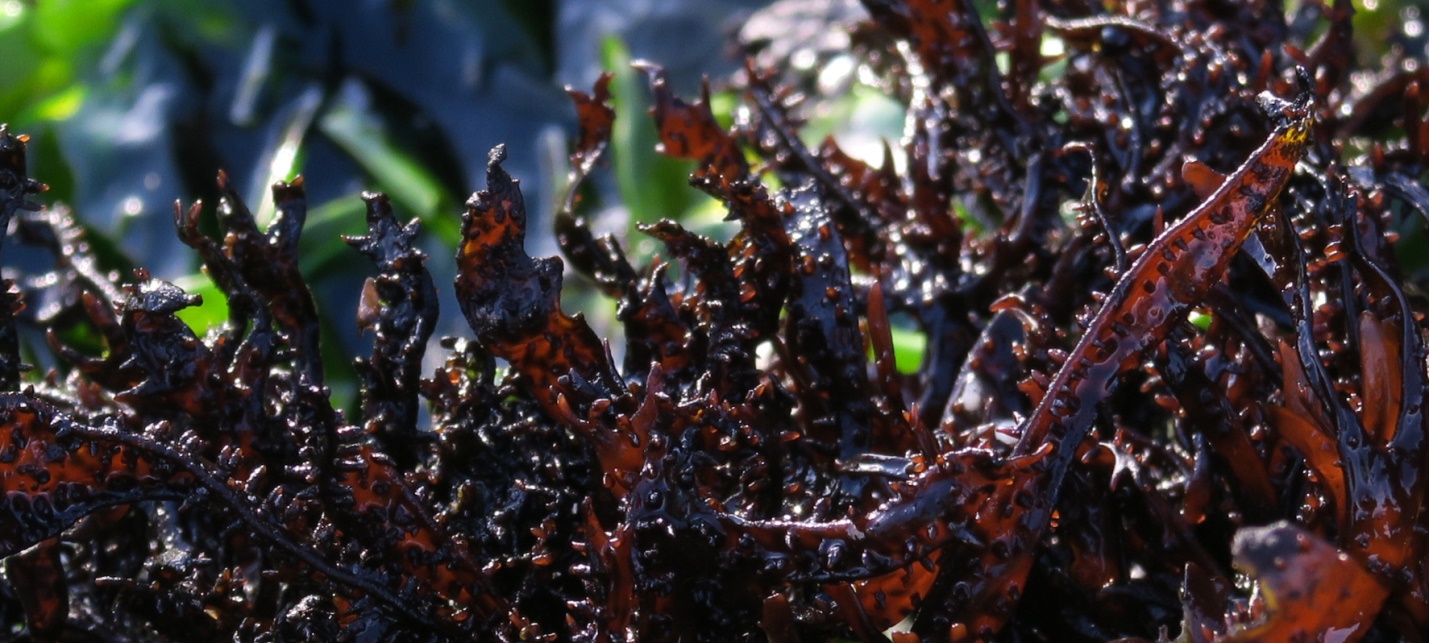
Mastocarpus agardhii
Narrow Turkish Washcloth / Bushy Turkish Washcloth
Harling Point, Juan de Fuca Strait, British Columbia, Canada
29 August 2020 (2nd visit, 31 August 2020; weather data not noted)
Observed at 7:35am PDT
Low Tide 2.0 feet at 07:42am PDT (measured at Oak Bay Point Tidal Station)
Weather: Clear with encroaching fog, no precipitation, wind variable 0-10km/hour, sea rippled, temperature 13˚C, relative humidity 94%.
Phase of Moon: Waxing Gibbous (approx. 46 hours into this phase at time of observation/collection); (Previous Phase, First Quarter, 25 Aug 2020 at 10:57am PDT: Next Phase, Full Moon, 1 Sep 2020 at 10:22pm PDT.)

Figure 1: Mastocarpus agardhii, Narrow Turkish Washcloth – this view of the very bushy red alga shows the narrow and long stipes/aphophises that support the numerous veriform-papillae dotted branches. Harling Point, Juan de Fuca Strait, B.C., Canada. August 29, 2020. Photo ID 27285 ©Seaweedwhisperings.com
All observations were done in-situ. We interacted with the live seaweed in the mid intertidal zone; the seashore here is a place where igneous bedrock meets the ocean.
Person 1:
Bushy – deliberately messy hairdo.
Stands out at close range, but not in the landscape.
Bright attitude.
Erect.
Likes to stand out on bare patches of rock.
Not afraid of the elements, e.g. being exposed at low tide.
Fronds are like tongues, curled up at the ends.
Papillae give the seaweed a rough superficial appearance.
The feel (touch) matches that appearance.
Pleasing olive purple coloration.
When I ran the palm of my hand over the seaweed I experienced a soothing roughness.
Bases of the stipes are very narrow giving a top-heavy sense to the seaweed.
Out of water these narrow stipes cannot hold the whole ‘bush’ upright, but the bushy top of the plant itself is stiff and erect.
I have a fascination with this plant, wanting to explore more.
Double-edged saw blade.
Papillae are suggestive of a tongue, and the shape of the blade is forked – reminds me of a snake’s forked tongue.
No smell.
Crisp texture upon biting.
No taste? But slight peppery aftertaste, that didn’t register until more than a minute after initial tasting. Later developed a prickly tingling on my tongue that lasted many minutes.
All the common names but “bushy” seem to be not quite appropriate. Narrow – not much meaning on its own, only when compared with the other Mastocarpus species. Washcloth – meaningless related to this species, has no resemblance to a washcloth.
Person 2:
In the low golden morning sunlight you stand out.
Many other times you are far less easy to spot.
You stand out now, why…, when no one is here to see you but a Pectoral Sandpiper winging by and two early morning seaweed explorers? Perhaps you didn’t notice others were nearby and you were not alone?
Your deep red brown burgundy color glows with the sunlight, and your ridged blades and bumpy papillae contrast well against the overall color.
You look splendid!
Have you been building up your splendor, hiding right here in plain sight?
Coloration can be rich and regal looking or matte black and very dull and lifeless looking.
Your blades are very narrow, and flare out only slightly.
You are streamlined but in a scraggly way.
A shape that possibly can withstand greater assaults of the waves and wind.
Each of your many branches has a similar reach (length) and they reach in ALL directions.
This does form a rather pleasing overall bushy shape.
The bases of your blades are very narrow – only 1-2 mm.
The ends of your blades widen out (2-6mm) and are tipped with forks. This is where the papillae are.
One single narrow stipe branches out into so many sub-branches – very bushy, profusely bushy indeed!
Touching you is a pleasant textural experience.
You’re not abrasive, but you do have definite “body”.
The ridges along the edges of your blades, your papillae, and the water retained on your flattened surfaces, all play with the light and form many visual impressions.
Some marine critter has laid eggs on your blades – you seem unbothered by this; you’re busy with your own agenda.
Chewing a piece of this seaweed, there is a distinct cartilaginous texture; crunchy. The taste of iodine is there, faintly. There is little reward to eating you and you don’t seem to be grazed by other more ‘natural-to-your-environment’ predators either.
No smell to you, just the smell of the seashore in the breeze.
Feel…, I think you’d feel very similar underwater, cartilaginous and textured.
If today were hotter and windier, I suspect you’d harden up, stiffen up and retain your integrity well.
In fact, for this late in the growing season (right on the cusp of September in the temperate zone) you are a beautifully strong and looking in your prime individual.
It is a lovely calm sea this morning, and it is encroaching gently (with the incoming tide); the time we have left to visit here is measured.
Thinking about your genus name, “Mastocarpus”, – “masto”, made me think of masts on sailing ships, each ship off to explore unknown shores. Some ships are destined to find new land, some to be crushed on reefs in uncharted waters. “Carpus”, although not an accurate translation, made me think of body. A mast-like body or a body atop a mast, yes, that fits. Narrow or bushy – both are apt descriptions and also helpfully comparative against others in your genus. Turkish Washcloth – bumpy texture like a terry towel cotton washcloth gone stiff.

Figure 2: Mastocarpus agardhii, Narrow Turkish Washcloth – individual darkened and desiccated, the consequences of a series of very low tides during hot and sunny weather. Harling Point, Juan de Fuca Strait, B.C., Canada. August 29, 2020. Photo ID 27286 ©Seaweedwhisperings.com
Further Observations & Impressions:
Person 1:
Liveliest seaweed in its surroundings.
Truly happy and “alive”.
Content.
Free, carefree.
Perhaps superficial, not introspective.
Maybe “big fish in a small pond”, stands out at close range but not in the landscape.
Nonchalant sexual expression.
The shape of the blade of this seaweed is like a ‘forked tongue’. That expression often connotes telling lies or speaking deceptively; the feeling here is this seaweed can often speak in ways that can be easily misinterpreted. Confusion and lack of clarity for the listener abounds.
Speaks without thinking. This is like a specialist in some field of study that rattles on about his new scientific findings to a person who has never studied science. What is being spoken is correct, but it is unintelligible to the inappropriate audience.
Unconcerned and unaware about what others think. This gives them the narrow scope to focus and explore their world freely.
Self-sufficient – strongly so.
Person 2:
Compact and tidy / organized.
Don’t take up much space externally, but there’s much going on within/internally.
Reach out in many directions.
Do you remember everywhere you’ve previously reached? Or are those merely stepping stones for your following efforts / investigations / growth?
I think you leave the stepping stones behind. They’re necessary but not where the “action” is, not at all.
Are you shy?
Compared to your neighbours – Sea Cabbage so large, Ulva so profuse and spreading, Halosaccion glandiforme so bold in its simple form, you are less noticeable. But maybe that suits you – to quietly forge on whilst others catch all the attention.
Your energy is not shy or timid, you actually simply prefer anonymity except, perhaps, for that ‘golden hour’ of sunrise splendor / brilliance. The ‘limelight’ is something you are not quite ready for. You have more work to do.
Bristly – the size of your papillae (in comparison to your blades) is large. Do the bristles indicate how you protect yourself, or is it how others experience you – bristly?
Bristly looking, almost thorny looking – like a cactus or a hawthorn; who / what do you want to keep away?
Are interactions troublesome or awkward – thorny?
Your streamlined structure is trim and efficient, and there is a grace and strength to you like that of a long-distance runner, and you are also rather thin and bony. There is nothing extra or superfluous to your physical structure.
You feel content, even happy in your preoccupations, and there is also a hunger in you, something you are seeking. Something you’re doing all that branching and extending and reaching for – something you’ve yet to attain or find.
Does this frustrate you?
At times, yes, very much! But it also propels you, drives you on in your efforts.
Do you have a direction?
No – not a single direction at all, you try ALL directions. And sometimes this means you miss seeing the most satisfying way forward. How disappointing that must feel! How narrowly you can miss it – “Narrow” Turkish Washcloth!
But you don’t give up. You are not a quitter.
You might however benefit from a bit more “input” from those around you. They do it differently, yes, very much so, and therein may lay the piece, the clue, the next stepping stone you are searching for. You mostly feel that you know how to go about what you’re going about – you’re quite busy with that, in fact, and therefore input isn’t often thought of; you’re busy, content, fully occupied.
Sexuality? Androgynous – feels like all options are open.
And sexuality is necessary but not a driving force, not a major component of your being.
So what is the driving force for you?

Figure 3: Mastocarpus agardhii, Bushy Turkish Washcloth. In hand is the cluster of the numerous distal forking branches of a single stipe – bushy indeed!August 29, 2020. Photo ID 27287 ©Seaweedwhisperings.com
Leaving the seashore:
Stiff. After sitting for about 45 minutes alongside the seaweed, both of us felt physically stiff as we tried to stand up. Joints stiff, movements distinctly not limber.
While we were doing this interaction, fog rolled in from an unusual direction (Haro Strait rather than Juan de Fuca).
Discussion:
In the first part of our ‘discussion’ period, we struggled with feeling that our interaction with this seaweed was not ‘complete’. This we came to realize was because we had not consciously acknowledged the two phases of this seaweed – the crust phase and the foliose phase. We had themes / experiences from both phases and when they were put all together we honestly wondered if we had been working with two different seaweeds (even though both persons were experiencing/working with the same plant). Some aspects felt only ‘partially’ accurate or somehow ‘not well-enough expressed’. We knew it was troublingly NOT ‘complete’ and NOT ‘finished’; so much so that we considered going back a second day to experience the seaweed again in situ and to fill out our experience of it, or to simply scrap the whole effort and start a new one some other time. Once we incorporated the two phases, we saw how these perplexingly different aspects could co-exist in the same seaweed energy.
Before recognizing this key dichotomy, Person 1 was certain that there was nothing else to add, no further or deeper explanation necessary. He was genuinely unaware that anything was ‘missing’. Person 2 was very aware that something was ‘off’; she struggled to comfortably reconcile the disjointed picture that had been assembled. How could the quality of “superficiality” (noted by Person 1) be compatible with “much going on internally” (noted by Person 2)? This felt much more complex than just a simple polarity. It was as if we each had a grasp on only one phase, or only part of, this seaweeds life form. We were totally unaware of the energy of the other form.
So…, we went back to the seashore and our seaweed…

Figure 4: Mastocarpus agardhii, Bushy Turkish Washcloth foliose form sprawling (top center); lower half of photo, left to right, shows – green Ulva spp. seaweed, part of a Katarina tunicata chiton, the tar /crust of M. agardhii (just above some pink coralline aglae) and finally part of a blade of Sea Cabbage seaweed. Harling Point, Juan de Fuca Strait, B.C., Canada. August 31, 2020. Photo ID 27288 ©Seaweedwhisperings.com
Part two:
Two mornings later, with the same 2.0 foot tide, we returned to gather more observations/experiences with this seaweed.
Person 1:
Tar forms a very thin crust.
It is the same shiny blackish color as the Katarina tunicata chiton living adjacent.
Top heavy fronds of the seaweed hide the tar/crust. It’s not obvious.
Base of plant (lower stiff parts) is strong and orderly. This strong base provides security, a comfort zone that enables the plant to explore fearlessly outward.
Person 2:
We’re back again, Mastocarpus agardhii. Oh, I’m not so sure you’re happy to have been ‘noticed’ like this. My world is intersecting with yours. I initiated this contact, not you. Your prefer it to be the other way around - that you would be the one to initiate and pursue the explorations / investigations.
Where is your crust / tar spot?
Two days ago, even though I knew your species has this other phase, I did not see it, and more significantly, did not even think to look for it.
With this first plant I’m observing today, I cannot discern a patch of tar. Your bushy foliose form is seemingly growing independently of any crust.
Is your crust very small?
Or is it simply not directly adjacent?
The tar, once I found it, is quite thin, can look like a wet rock and so is easily not seen despite being present.
The crust / tar has a look of wet paint rather than a gob of thick tar (as we’ve seen with M. papillatus).
Your crust has very fine ‘pores’; nearby M. papillatus crusts have noticeably larger ‘pores’.
Younger blades and some full sized ones have no papillae and only a few forks – are these only getting started?
Bushy Turkish Washcloth individuals do tend to grow in clusters; however they are well-spaced, not crowded next to each other.
Discussion:
The crust phase of this seaweed is inconspicuous, easily overlooked, yet it is an integral part of the whole. We struggled with the awareness of ‘absence’; something was missing, something was not yet discernable to us. We wonder now if that is a key aspect to the energy of this seaweed – what drives it forward in its investigations could be this very thing, the desire to find what is missing or absent or not yet discerned or understood.
Mastocarpus agardhii exists on a different scale – both in physical size and in way of being. Likely does not fit in with the norms of society – its way of being is independent, little-influenced by those around it. Doing it “my way” is innate – it’s not a reactive stance.
And what is “my way” for this seaweed? Its mode of being is “explore everything” – it’s definitely not single tracked.
Is this another purpose / motivating force – to explore?
The urge to explore is innate, and it also appears that it can become all encompassing. This can make them oblivious to or disconnected with what’s occurring around them. They can be busy with their agenda and not noticing or caring much about what others think.
This seaweed is always hungry, physically and intellectually – never quite satiated. Physically, it doesn’t have energy reserves, only enough fuel to get to the next meal/tide. Like a hummingbird or a marathon runner, extra body weight / fat reserves would impede progress. Intellectually, the ‘hunger’ is a certain awareness that there something missing, something not yet discerned, more out there to be discovered.
Top heavy – lots of action in the head / mind, not so much, comparatively speaking, in the body. Brilliance of thought / ideas interests you more than the excellence or fitness of your physique. The ‘body’ of this seaweed, trunk and legs, is often not even seen, because the ‘head’ is so prolific with branches. What does this give you / cost you? Possibly a bit more input from your body would also be useful?
Confident, unafraid, streamlined, able to withstand assaults, able to persevere - these are the natural strengths of this seaweed. Lively and vibrant, this energy seems to have the ability to do most anything, “set sail for any shore” so to speak, should it choose to apply their will.
Fascination was a key feeling with this seaweed. Some will frolic in pools of never-ending fascination and exploration. Others will have that fascination lead them somewhere.

Figure 5: Mastocarpus agardhii, closer view of papillae and swollen blade edges, two of the diagnostic morphological features. Harling Point, Juan de Fuca Strait, B.C., Canada. August 29, 2020. Photo ID 27289 ©Seaweedwhisperings.com
Biology & Natural History Information:
Description:
The gametophyte of this red alga is dark reddish-black, cartilaginous, and grows upright to 15cm tall with its stipe composing one third to one half of this height. The stipe is somewhat cylindrical and fairly smooth expanding into narrow blades; branching, is more or less dichotomous or divaricate, up to six orders and may be as wide as at right-angles. Margins of the apophysis and blade are slightly swollen, giving the thallus its canaliculate character (grooved or channeled longitudinally). The tips of female specimens are narrowly rounded, while those of males are slightly round-toothed or scalloped. This species has worm-like bumps (vermiform papillae) on its blades. Like Turkish Washcloth, M. papillatus, this species alternates with a diploid Tar Spot crust.
Habitat: On rocks in the low to mid-intertidal in semi-protected to exposed habitats.
North Pacific Distribution: The ranges and correct nomenclature for species in the Mastocarpus genus is challenging due to morphological variability within species and morphological similarity between species. Recent research, Lindstrom et al (2011), reviewed the genus and as a result what was formerly known in our region as Mastocarpus jardinii was split into four separate species, one of which is Mastocarpus agardhii. Verified distribution includes Monterey Peninsula, California, north and west Vancouver Island, B.C. and Calvert Island on the Central Coast of British Columbia. Scientists acknowledge it is likely that some species of Mastocarpus in the northeast Pacific are more widely distributed than documented collections indicate.
Remarks:
Other Mastocarpus species can appear very similar; other species of the genus reported on the B.C. coast are M. vancouveriensis, M. intermedius, M. papillatus, M. alaskensis, M. latissimus and M. rigidus.
Classification:
Phylum: Rhodophyta
Class: Florideophyceae
Order: Gigartinales
Family: Phyllophoraceae
Genus: Mastocarpus
Species: Mastocarpus agardhii (Setchell & N.L.Gardner) S.C.Lindstrom, Hughey & Martone 2011
![]()